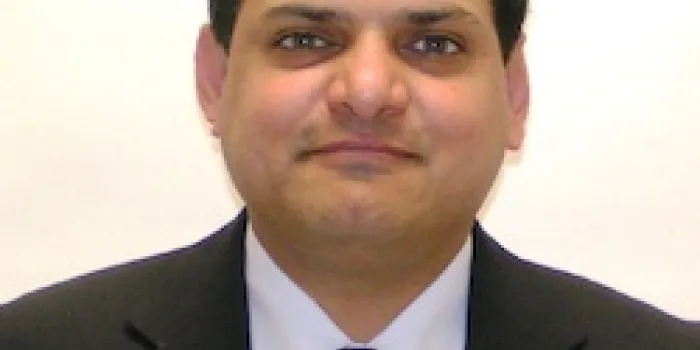HemAware is conducting a series of interviews with recipients of the NHF-Shire Clinical Fellowship. It is funded through the generous support of Shire. The objective of this grant is to increase the number of skilled clinicians committed to providing comprehensive care for individuals with bleeding and clotting disorders and to prepare recipients for academic careers.
This interview was conducted with Raj Kasthuri, MBBS, MD, assistant professor of hematology and oncology at the University of North Carolina at Chapel Hill. He is an adult hematologist at the UNC Hemophilia and Thrombosis Center (HTC) and director of the UNC Hereditary Hemorrhagic Telangiectasia (HHT) Center of Excellence. The fellowship was funded from 2004 to 2006.
Why did you decide to study medicine?
Kasthuri was born and raised in Salem, India, in a family with three generations of physicians. “My memories of childhood are running with my dad to his clinic,” he says. Those were the days when physicians still made house calls. “I remember going with my dad on home visits in the evening, carrying his doctor’s bag for him.” Kasthuri’s father was trained as an internist and surgeon, a career pathway he expected to follow.
What initially attracted you to hematology?
“During my training at Kasturba Medical College in Mangalore, India, I found that I was more enamored with the medical specialties rather than surgery,” Kasthuri says. He came to the U.S. to pursue internal medicine, training at Michael Reese Hospital in Chicago. That’s where he met Margaret C. Telfer, MD, a dynamic hematologist who influenced his medical career. “Peggy’s passion for hematology was infectious,” Kasthuri says. “There were many times during my rotations with her when I would think, ‘This is what I want to do for a living.’” Determined to follow that hunch, Kasthuri went to the University of Minnesota (UM) to train in hematology/oncology.
How did the training and mentorship you received as an NHF-Shire Clinical Fellow affect your decision to pursue clinical care and/or research in bleeding disorders?
Kasthuri says his mentor, Nigel Key, MB ChB FRCP, director of the UNC HTC, told him about the fellowship during his second year at UM. “Dr. Key identified the NHF-Shire Fellowship as something I should look into and apply for. He’s been my mentor since I started my training in hematology/oncology.” The fellowship helped Kasthuri transition to a junior faculty position and allowed him time to initiate research projects. “It helped launch my research career,” he says. “The training that I pursued as an NHF-Shire Clinical Fellow continues to benefit me to this day.”
Are you still engaged in the clinical aspects of patient care or bleeding disorders research? What aspect of care are you most interested in?
Kasthuri divides his time between taking care of adult patients with disorders of hemostasis and thrombosis, teaching at the UNC School of Medicine and conducting research. He is also busy directing the UNC HHT Center of Excellence, one of only 12 in the country. Career development awards from the National Institutes of Health and the Hemostasis & Thrombosis Research Society currently fund his research. “All of these have ensured that I continue to do what I wanted to do,” he says. “All of it started with the NHF-Shire award.”
Did your NHF-Shire Clinical Fellowship assist in advancing your position at your institution? Or did it serve as a building block to further your career in coagulation?
Although Kasthuri says it was more of a building block, the fellowship did solidify his position at UM. “When you are a third-year fellow, and you’re looking for a faculty position, the more funding and support you have, the easier it is to get that job.”
Where do you think bleeding disorders research and clinical care may be headed in the near future? In the next decade?
Kasthuri says that extending the half-life of clotting factors is an imminent clinical care change. “That is going to change the way we take care of at least certain aspects of hemophilia care,” he says. Beyond that, he predicts that gene therapy trials are going to proliferate, including one at his institution led by Paul E. Monahan, MD. “We have had recent publications on gene therapy that are encouraging,” Kasthuri says. “That has now spurred on the next wave of trials that are getting geared to go.” Although gene therapy has been discussed for decades in the bleeding disorders community, Kasthuri mentions the progress made recently. “I think we’re closer to it today than we have ever been.”
What profession would you be in if you weren’t in medicine?
Despite being surrounded by a close-knit family of doctors, Kasthuri did contemplate a completely different career path at one point. “Before getting into medical school, I toyed with the idea of becoming an architect,” he says. When he was younger, Kasthuri spent his free time drawing and building things. His mother is an accomplished artist, and her works prompted him to at least consider a change of plans. “Our house is full of paintings done by my mom, and so are probably the houses of all of my relatives,” he says, laughing. “That’s probably where it comes from—that’s the gene pool.”
Learn More:
How to apply for the NHF-Shire Clinical Fellowship.

